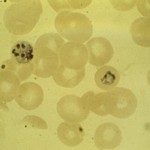Lien vers Pubmed [PMID] – 2465148
Eur J Biochem 1989 Jan; 179(1): 23-9
Transitions in the expression of the myosin light chains (LC) were investigated in fast-twitch muscles of the rat during chronic (10 h/day), low-frequency (10 Hz) stimulation. Changes were followed at the mRNA level by Northern blot analysis and in vitro translation, as well as at the protein level by electrophoresis under denaturing and nondenaturing conditions. In vivo synthesis of the light chains was assessed by measuring the incorporation of intramuscularly injected [35S]methionine. Chronic stimulation induced a transition in the isomyosin pattern with an increase of FM3, a concomitant decrease in FM1 and, after longer stimulation periods, the appearance of low concentrations of the slow isomyosin. These changes were accompanied by an elevated LC1f/LC3f ratio and increases in the amounts of both the LC1sb and, to a lesser degree, LC2s proteins. Alterations in the amounts of specific mRNAs were the same whether determined by Northern blot analysis or by in vitro translation of total RNA preparations from the same muscles. Generally, the changes in the relative concentrations of fast and slow light-chain proteins agreed with the changes detected at the mRNA level and the alterations in protein synthesis detected with the use of an in vivo labeling assay. An exception was the elevated tissue content of LC2s where no changes were detectable in the concentration of its mRNA as determined by in vitro translation or in vivo synthesis. The increase in LC2s protein may, therefore, have been due to reduced degradation. In addition, the decrease in LC3f was more pronounced at the protein level than at the mRNA level. This might indicate an increased turnover of LC3f or the existence of additional post-transcriptional regulations of LC3f expression.

